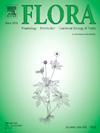纳米型和体积型CdO对普通Hordeum光合机构的植物毒性效应
IF 1.8
4区 生物学
Q3 ECOLOGY
引用次数: 0
摘要
研究了纳米分散形式和宏观分散形式的CdO对普通Hordeum vulgare L.幼苗光合器官的毒性作用。纳米级cdo的应用降低了叶绿素和类胡萝卜素的浓度,而大量cdo的应用对叶绿素和类胡萝卜素的浓度没有显著影响。与此同时,叶绿素前体5-氨基乙酰丙酸的水平在所有处理中均比对照提高了31% ~ 57%。叶绿体的超微结构研究表明,在体积和纳米cdo的影响下,叶绿体的大小减小,有序的类囊体组织被破坏。光合电子传递链关键基因的表达分析显示,低污染浓度下表达量上升,高浓度下表达量下降。然而,幼苗的光化学活性呈剂量依赖性下降。在高浓度纳米cdo的作用下,荧光的非光化学猝灭(NPQ)增加了2倍以上。此外,高剂量和低剂量的化合物均抑制ATP合成酶基因和卡尔文-本森循环酶基因的表达。同时,戊糖磷酸途径和末端氧化酶基因上调,表明在光合效率下降的情况下,保护机制被激活。光合作用的抑制反映在非结构性碳水化合物水平上,所有处理均降低了非结构性碳水化合物水平。研究结果强调需要评估重金属纳米颗粒对光合作用和植物生产力的长期影响。本文章由计算机程序翻译,如有差异,请以英文原文为准。
Phytotoxic effects of nano- and bulk-form of CdO on photosynthetic apparatus of Hordeum vulgare
The toxic effects of nano- and macro-dispersed forms of CdO on the photosynthetic apparatus of Hordeum vulgare L. seedlings have been studied. The application of nano-CdO reduced the concentration of chlorophylls and carotenoids, while bulk-CdO did not cause significant changes. At the same time, the level of the chlorophyll precursor, 5-aminolevulinic acid, increased by 31% to 57% compared to control in all studied treatments. Ultrastructural studies of chloroplasts revealed a decrease in their size and disruption of the ordered thylakoid organization under the influence of bulk- and nano-CdO. Expression analysis of key genes of the photosynthetic electron transport chain showed a rise in expression under low pollutant concentrations and a decline under high concentrations. Nevertheless, the photochemical activity in the seedlings tended to decrease in a dose-dependent manner. Under the influence of high concentrations of nano-CdO, there was more than 2-fold increase in non-photochemical quenching (NPQ) of fluorescence. Moreover, both high and low doses of the studied compounds suppressed the expression of ATP synthase genes, and genes of the Calvin-Benson cycle enzymes. At the same time, upregulation of genes of the pentose phosphate pathway and terminal oxidase was observed, indicating the activation of protective mechanisms amid decreased photosynthesis efficiency. The suppression of photosynthesis was reflected in the levels of non-structural carbohydrates, which were reduced in all treatments. The research results emphasize the need to assess the long-term effects of the heavy metal nanoparticles on photosynthesis and plant productivity.
求助全文
通过发布文献求助,成功后即可免费获取论文全文。
去求助
来源期刊

Flora
生物-植物科学
CiteScore
3.30
自引率
10.50%
发文量
130
审稿时长
54 days
期刊介绍:
FLORA publishes original contributions and review articles on plant structure (morphology and anatomy), plant distribution (incl. phylogeography) and plant functional ecology (ecophysiology, population ecology and population genetics, organismic interactions, community ecology, ecosystem ecology). Manuscripts (both original and review articles) on a single topic can be compiled in Special Issues, for which suggestions are welcome.
FLORA, the scientific botanical journal with the longest uninterrupted publication sequence (since 1818), considers manuscripts in the above areas which appeal a broad scientific and international readership. Manuscripts focused on floristics and vegetation science will only be considered if they exceed the pure descriptive approach and have relevance for interpreting plant morphology, distribution or ecology. Manuscripts whose content is restricted to purely systematic and nomenclature matters, to geobotanical aspects of only local interest, to pure applications in agri-, horti- or silviculture and pharmacology, and experimental studies dealing exclusively with investigations at the cellular and subcellular level will not be accepted. Manuscripts dealing with comparative and evolutionary aspects of morphology, anatomy and development are welcome.
 求助内容:
求助内容: 应助结果提醒方式:
应助结果提醒方式:


